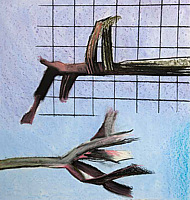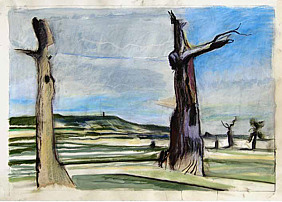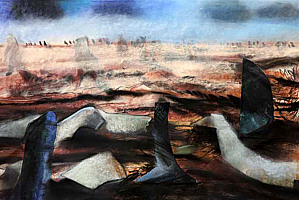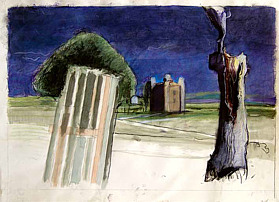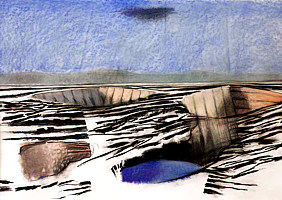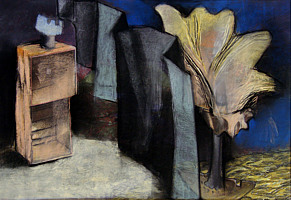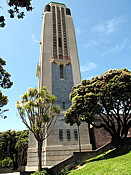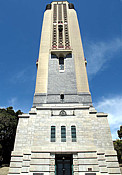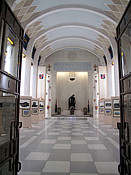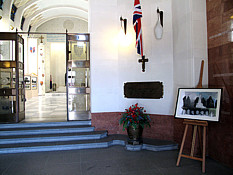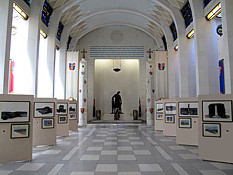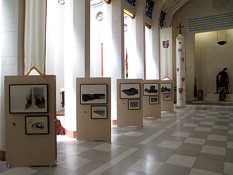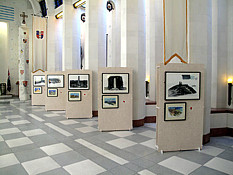H O M E • V
O R T E X 1 • V
O R T E X 2 • V
O R T E X 3 • V
O R T E X 4 • V
O R T E X 5 •
P E R S O N A
L B L O G

 |
| Exhibitions These pages will host selected online versions of Paul Gough's exhibitions, current and archived as they become available. PAUL GOUGH Drawology : Group exhibition Autumn 2013 curated by Nottingham Trent University, dates in Nottingham, 18th November 2013 - December 13th 2013 Touring UK in 2014 Drawing is said to have the ability to record both its own making and the movement of the thoughts and body of the drawer. Bringing together the work of several artists with differing practices, Drawology aims to consider whether this premise is applicable to a specific process or genre of drawing or whether it is applicable to drawing generally. The works in the exhibition represent an expanded field of contemporary drawing in a Fine Art context to include: works on paper, performance, moving image, installation, projections and three-dimensional drawings. PAUL GOUGH ‘Write off the Map’ Group exhibition and project, St John on Bethnal Green, London, 6th - 10th June 2013, curated by Amy Cutler • http://amycutler.wordpress.com/2013/06/ PAUL GOUGH EDGE:LANDS. Drawings and Paintings by Paul Gough. Bath Royal Literary and Scientific Institution, Jenyns Gallery, Bath, Somerset, 5th November - 30th November 2012 Paul Gough is interested in drawing in-between places, liminal zones, waste grounds, empty places that were once something and now have been allowed to lapse back into their habitual shape. Look at his drawings of the former airbase at Greenham Common, or the ash-heaps of the old north Somerset coalfield, the abandoned village of Tyneham or the forlorn gullies on the Gallipoli Peninsula. They are powerful evocations of absence and embedded memory. Writer Marion Shoard coined these unloved, unseen and often unexplored spaces as the ‘edge land’, a mysterious hinterland of brick piles and rubbish tips, derelict industrial plant and ragged landfill, forlorn filling stations and scruffy allotments, abandoned ordnance lying amidst rogue plants. Thirty years ago, the naturalist Richard Mabey in his book ‘The Unofficial Countryside ‘, had also opened our eyes to the vitality of these unkempt places. He, however, found little to cherish and celebrate in these wasted hinterlands. Instead he marvelled at the resilience of nature in such abject conditions, its refusal to be ground down by toxic contagion. Mabey's astonishment at the hardiness of nature is a reminder of another astute observer of the English scene, the painter Paul Nash. Before the Great War a modest painter of fluffy elms and vapid sunsets, Nash was transformed by his experiences while serving as a British officer on the Western Front in 1916. In 1916, in a letter home he wrote of walking through a wood (or at least what remained of it after recent shelling) when it was little more than 'a place with an evil name, pitted and pocked with shells, the trees torn to shreds, often reeking with poison gas’. A few days later, to his great surprise, that 'most desolate ruinous place'; was drastically changed. It was now 'a vivid green', bristling with buds and fresh leaf growth:
a nightingale. Ridiculous mad incongruity! One can't think which is the more absurd, the War or Nature...' More recently, two young British poets have also wandered in (and wondered of) the hinterlands that make up the British banlieue. To Paul Farley and Michael Symmons Roberts the wilderness is much closer than any of us think. They describe the English edgeland as a set of familiar yet ignored spaces, ‘passed through, negotiated, unnamed, unacknowledged’, which are now the new wild places on our very own doorsteps. Theirs is a compelling vision, shared in Gough’s many images of former sites of battle, abandoned workings and ancient slagheaps, a land riddled with trenches and troughs, adits and mineholes, ivoried elm and wild buddleia. Gough’s drawings are not representations of any one particular scene. Instead they are accretions of places, spaces, times and seasons brought together on to a single surface; they are sites of both legend and anonymity, places emptied and yet full of emptiness, dis-membered topographies that have had their constituent parts re-membered through the act of drawing. In his drawings, created over decades of measured practice, Gough has laid vision to his own complicated, unkempt and previously unexamined edgeland. He has made tangible those places that have long thrived on disregard. In his work he meets the challenge that we should ‘put aside our nostalgia for places we’ve never really known and see them afresh’. M.R.H. PAUL GOUGH Remembrance and Restoration: Exploring the Imagery of War, Resurrection and Recovery Otter Gallery, Chichester, 19th November 2009 – 10th January 2010 (one person show) To mark the 90th anniversary of the peace conferences that were staged at the close of the Great War, the Otter Gallery is hosting an exhibition of drawings, paintings and photographs that explore the imagery of remembrance. At the heart of the show is the Otter Gallery’s unique collection of studies for Stanley Spencer’s ‘Resurrection of the Soldiers’ which forms the end wall of the Sandham Memorial Chapel at nearby Burghclere. Spencer died 50 years ago this year, and his work will be shown alongside contemporary and contextual images which explore the representation of caring, peace and recovery. Curated by Paul Gough PAUL GOUGH An Exhibition at National War Memorial Carillon Building (Part of Blow 09) Wellington, New Zealand, Wed 11 November - Sat 19 December 2009 Curated and Photographed by Jeremy Diggle
Paul Gough is a painter, broadcaster and writer and at the time of this exhibition in 2009, became the Pro Vice-Chancellor Research, Enterprise and Knowledge Exchange, at the University of the West of England, after 12 years as their Executive Dean of Creative Arts. Paul had also recently been the Chair of the Art and Design Panel in the Research Assessment Exercise (RAE) 2008, the United Kingdom’s equivalent to New Zealand’s Performance Based Research Fund (PBRF). His recent research covers the aesthetics of conflict, landscapes of dereliction, and the iconography of commemoration. He has published widely in art history, cultural geographies and material culture and exhibits his paintings internationally. Paul’s large-scale history paintings, with a strong military theme, are in many private and public collections, including the Imperial War Museum, London and Canadian War Museum, Ottawa. He has shown widely in UK and abroad, and has had one-man shows in Canada, London, Manchester, Lancaster and Bristol.
He has a Masters in painting and a PhD in cultural history from the Royal College of Art. His most recent book, about ten painters from the Great War, is published this summer. This exhibition, aptly located at the National War Memorial Carillon building in Wellington, is a must see for all those interested in exploring the visual cultures of war, memory, place and identity. Paul Gough: iconography of commemoration Paul Gough is interviewed by Radio New Zealand's Chris Laidlaw for his Sunday Morning National programme on 8 November 2009 in anticipation of his visit to Aotearoa, New Zealand to participate in Blow '09, Massey University's creative art festival (duration: 16'43) PAUL GOUGH ‘Error 3’ Safia Gallery, Barcelona, Spain 14 March – 2009; Vyom art Gallery, Jaipur, India, September 2009 ACiD members Professor paul Gough and John France are to feature in an international exhibition at the Galleria Safia in Barcelona in March 2009. The two artists will be showing two pieces of recent work each. The Safia gallery opened in 1991 with the objective of supporting and spreading knowledge of contemprary art, artists and prcatice to all sections of the public. They support both projects by young and new artists as well as those by established, recognised artists. • View Gallery PAUL GOUGH Recent Drawings Sir John Cheshire gallery, April - May 2004 Two steps as the subject of a picture must inevitably provoke comment. Where do they lead? Why are they significant in themselves? What are they doing, literally, in the middle of nowhere? And who, therefore, might ever use them? Paul Gough’s picture ‘Mount’ is but one of a series of works which invites such conjecture. Nor does it stop there. What of the idea of steps? Do they suggest progress, ascent (or perhaps descent), or are they just man-made objects in a natural, if starkly barren, environment? The visual arts in themselves rarely provide straightforward explanations but, in the odd juxtaposition of the familiar and the incongruous, the artist here creates a particular mood of reflection. To Jersey eyes it has a particular resonance. You might say that it looked distinctly unreal except that a walk on Les Landes common reveals many such images telling their own story. Progress, ascent, descent? No, just a past conflict. The participants may have long departed but the landscape retains such extraordinary traces operating both on the level of historical artefacts, with their own narrative ready to be ‘discovered’ by the historian, but also at the symbolic level suggestive of the imposition of a foreign order on the natural world. With a doctorate in First World War Art and a fascination with the landscape of battle, Professor Gough is steeped in the traditions of war iconography. While his work is of the imagination rather than an attempt to render specific events, he knows that even an imagined landscape has a voice of its own. Artists have often found it easier to record conflict through such ‘voices’, partly, doubtless, for practical reasons but also perhaps because the horrors of war often translate with some difficulty to canvas or paper. As Robert Hughes once put it: “… distortion of the human body in art seemed to many sensitive minds to have no future – in fact, to be little more than an impertinence or an intrusion…Reality had so far outstripped art that painting was speechless. What could rival the testimony of the photograph?” Perhaps for this reason some of the most evocative images of war deal not with human carnage directly but rather with physical assault on landscape. Paul Nash’s Void (1918), which was used to promote the Barbican’s exhibition A Bitter Truth ten years ago, is a case in point. There are soldiers, alive and dead, to be glimpsed in miniature but prominence is rather given to shattered tree stumps, furrowed earth and the ‘corpses’ of the broken machines of war. Lone trees and stark objects which testify to human intrusion into landscape are images common to Paul Gough’s work. They occupy the space from which man has been expelled, leaving only the uneasy sense that some unspecified event is responsible for the silence and the solitude. Here, certainly, is peace but it is a peace which has been paid for by an irrevocable alteration of the natural world, a world bathed in the indeterminate light of the dream, or perhaps of the stage-set consciously manipulated by the designer to heighten or remove shadow by artificial means. The fact that these works seem to acquire a special significance in an Island whose landscape was transformed during the Occupation testifies to the power of art over historical record whose very specificity serves paradoxically to limit meaning. Paul Gough’s work is not ‘about’ any particular conflict; it deals with the relationship between memory and landscape. Through images which seem to belong to a collective consciousness or experience, we have a sense of the extent to which the natural order of things has been subtly disturbed by the unseen influence of man. PAUL GOUGH Loci Memoriae STONE Watershed Media Centre, Bristol UK Tuesday 25th September – Sunday 11th November 2001 DUST The Architecture Centre, Bristol UK Monday 1st October – Sunday 11th November 2001 Two Exhibitions by Paul Gough and invited artists
Two exhibitions of drawings, photographs and photo-montage that examined the legacy of 20th century war in the monumental architecture of our cities. Monuments are pivotal elements in the city’s symbolic furniture, they function as forms of civic art that help to contain and convey different levels of memory. They are rarely sited without consideration of their role in a symbolic topography and are often quite consciously situated to connect or compete with existing nodes of collective remembering. As the embodiments of power and memory, their meanings are rarely fixed and they still provoke anxieties and dispute. These shows were hosted by Watershed and The Architecture Centre, Bristol in association with the Centre for Contextual, Public and Commemorative Art at UWE Bristol and the Creative Urban Spaces Project, Bristol. A fully illustrated catalogue will be available. At the Watershed Paul Gough built a facsimile 2D model of the side of the Bristol Cenotaph which is coated in newspaper from the Gulf War and inscribed with the ‘high diction’ of remembrance – ‘Glorious, Memory, Fallen’. It stands 10 inches away from the wall like the fake buildings in a Western movie. Behind is a huge paper ‘wreath’ of red and black poppies. During the course of the 5 week show the surface of the cenotaph was altered – Gough whitewashed, then painted it with blackboard paint, later hanging it with white flags and other messages. As a final act of contrition a grafitti was to be invited to spray the word 'Glorious' across its lower half. The piece was dismantled at 2 minutes past eleven on the 11th November 2001. Also at the Watershed were photographs by Peter Ayley, an architect, who has taken a number of severe classical photographs of the silent cities on the Western Front. One image ‘Grahams’ shows a vast monumental wall of individually carved names – the sole memorial for those lost without trace on the Somme. At a parallel show at the Architecture Centre in Bristol Paul Gough was showing a suite of large drawings (1 m x 1.3 m) on the theme of monuments and commemorative form. The drawings emanate from years of engagement with the iconography and aesthetics of memorialisation. As an academic Professor Gough has published widely in the areas of war art and memorials. Much of his work is based on regular fieldwork in Normandy, the Somme, and the Gallipoli peninsula in Turkey. Some of the fragments of metal, ceramic and wood brought back from these sites of memory are incorporated into the drawings in this show. These exhibitions were a unique collaboration between the Watershed and the Architecture Centres in Bristol and have been supported by the Research Centre for Contextual, Public and Commemorative Art (CPCA) at UWE, Bristol and the Creative Urban Spaces Project, Bristol. • View Galleries A fully illustrated catalogue with an introduction by Andrew Kelly is available. |
